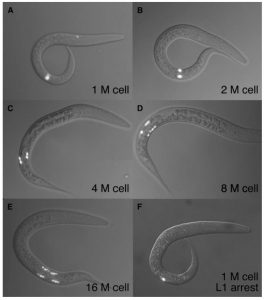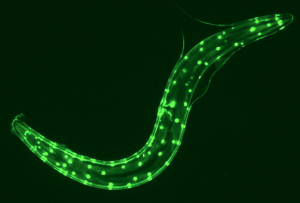Dr. Ryan Baugh grew up in Georgia and went to the University of Georgia, majoring in genetics. He entered college on the pre-med track, but he discovered that he was more interested in research than medicine. After graduating, he took a year off and worked full time as a lab technician before attending graduate school at Harvard. His gap year allowed him to learn valuable molecular biology skills, mature personally, and define his interests for graduate school so he could hit the ground running as soon as he began his graduate experience. In graduate school, he chose to work in a model organism lab based on respect and interest in the faculty in charge. Dr. Baugh found that c. elegans research satisfied both his need for a field that was compatible with his interests and perspectives as well as biomedically relevant and fundable. He also recognized nutrient availability and starvation were overlooked in developmental biology and saw an area of opportunity in studying these features in c. elegans, leading him to his current research focus today.
Dr. Baugh’s initial and overarching goal was to find a livelihood where he could both make a living and positively contribution to society. As an undergrad, he had a wide variety of interests, but he particularly loved nature, genetics, and studies of what makes us who we are (e.g. nature vs. nurture, heredity, etc.). By studying and researching biology, he hoped to develop a meaningful, almost spiritual appreciation for nature, viewing research as a way to “[meditate] on … nature in depth”. As he progressed through his educational and academic career, his objectives became more practical, such as getting into a good graduate program, finding a good lab, publishing papers, getting a job, getting grants, getting tenure, etc. However, through all the pressures and stresses of reality, he retained certain high-minded aspirations for himself, which he still preserves to this day. Through his research, Dr. Baugh puts in his best effort to simply do the best science that he can, such as perfecting papers, conducting well-executed experiments, and obtaining significant results. In this way, he views his research as a medium of personal expression, comparing it to art. He hopes that by doing research well that he’ll be able to discover results that extend beyond his field and impact humanity.
Dr. Baugh’s primary interests in scientific research are two-part. He likes the creativity involved with brainstorming about how to approach a problem for a new project and devising new strategies or technologies. He feels a tremendous sense of satisfaction when he can understand a complex problem well enough to design an informative experiment. Additionally, it’s exciting for him to make unexpected observations during experiments that force him to challenge his assumptions. On the other hand, he also enjoys having results make sense and come together like puzzle pieces after starting from the beginning knowing very little. He finds it especially rewarding when he is able to witness a project mature and achieve good results at any point in the process after plenty of hard work and frustration. Although there are many “lows” associated with doing research, he believes that living for all of the few and far between “highs” gets him through the many moments of setbacks and tedium.
Compared to research, Dr. Baugh feels more ambivalent towards his teaching experiences. Although teaching takes a significant amount of time and effort and is hard to do well, he believes that it is under-valued within the university with little recognition for good teaching efforts. Thus, teaching can feel like a distraction from research. However, Dr. Baugh still loves talking about science and sharing his knowledge with students as an expert and role model of sorts. He feels great commitment to his students and thrives on seeing students express enthusiasm towards the class’ subject matter and influencing their career interests. He prefers teaching seminars rather than lectures because they are more freeform, with more student engagement and better opportunities to get to know the students and see how they think.
More than anything, Dr. Baugh wishes that scientific research could obtain increased funding. He believes that it’s difficult to have good conscience and effectively train students to be scientists in an environment where many who work hard to get doctorate degrees will end up with a mediocre salary and not able to pursue what they would initially want to do. Additionally, he criticizes the negativity involved in peer review, publishing papers, and obtaining grants, which he believes is caused by primarily a lack of resources. He also believes that increased funding would allow science to be more productive and contribute further to the economy and society and make research on a day to day basis a more positive experience.
Although Dr. Baugh hasn’t had any particularly bad lab disasters other than getting a piece of glass in his eye once and having to use the eye wash station, he considers his many instances where figured out or discovered something that’s already known his most embarrassing moments. In grad school, he recalls wanting a particular reagent and spending two weeks making it himself, only to realize that the reagent was available for sale. He ascribes this as part of the nature of research and a particular saying: “A few months in lab can save a couple hours in the library”, meaning that researchers can become very engaged in the research process and neglect to do basic research on the topic of interest first to see what is already known.
Dr. Baugh has the following pieces of advice for budding scientists: make sure you enjoy and have fun with research, and don’t lose sight of that. It’s important to be playful and pursue curiosity, because that’s where everything starts. There are practical real world concerns, but if you lose sight of it, you won’t have as good of a time, and you’ll also be less likely to contribute significantly. Also, to be successful in science, you need curiosity and creativity to generate ideas and identify problems, but you also need a good dose of perseverance and grit to execute and actualize your ideas.
More practically speaking, for those that choose to pursue research as a lifetime career, Dr. Baugh claims that the job in truth is highly competitive and not a good way to make a lot of money. He also found it surprising how he spent years getting an education and training in lab doing experiments with his own hands, and then once he had the opportunity to start his own lab, he acquired more managerial or administrative responsibilities such as teaching or writing grants or training others. Thus, not to be discouraging, but those who pursue research really need to find it rewarding and satisfying overall and keep in mind that things that make you successful in the training part of your career are very different than what makes you successful afterwards when you’re independent, so adaptability is a necessary trait to have.



